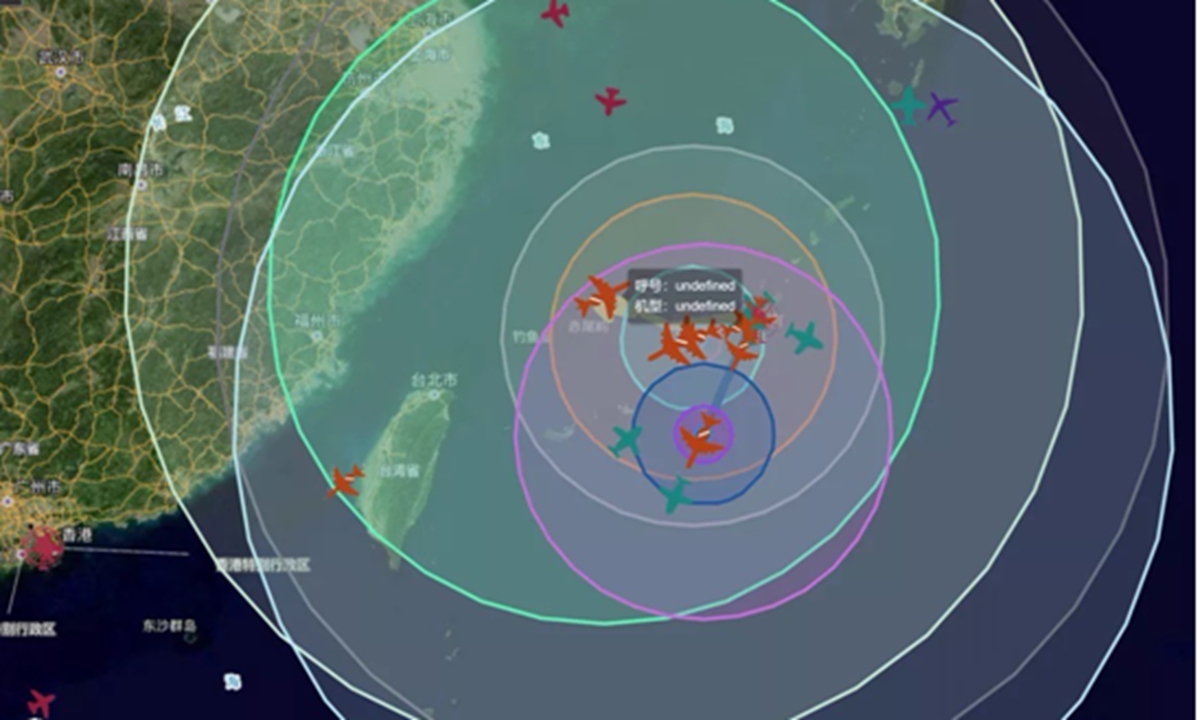US military uses balloons, disguises recon aircraft as civilian planes to spy on China: report

Several US military spy aircraft operate in the East China Sea and the Philippine Sea on August 9, 2022 amid PLA's large-scale exercises around the island of Taiwan. Photo: Courtesy of MizarVision
High altitude balloons are widely used for weather surveillance by countries around the world, but the US recently created a series of "spying" dramas hyping China's unmanned airship that went out of control, which not only built up tensions, but also seriously harmed China's rights through the use of force. An exclusive report obtained by the Global Times on Monday shows that the US military frequently conducted close-in reconnaissance on China, including the use of balloons, making the US the top spying country in the world.
In 2022, the US military carried out close-in reconnaissance operations in the South China Sea over 600 times using spy planes, MizarVision, a Chinese technology and intelligence company, told the Global Times, citing open source Automatic Dependent Surveillance-Broadcast (ADS-B) data.
The real figure could be higher, as some US aircraft turn off their ADS-B trackers or use fake ones, MizarVision said.
Similar close-in reconnaissance sorties also took place in the East China Sea, including in August, when the Chinese People's Liberation Army (PLA) conducted large-scale exercises around the island of Taiwan, according to the company's monitoring.
Frequently deployed aircraft include the EP-3E electronic signals reconnaissance plane, the P-8A maritime patrol and reconnaissance plane, the RC-135 reconnaissance aircraft, the E-8C airborne command and control plane and the U-2 high altitude reconnaissance plane, said the intelligence company.
The US military also uses other types of aircraft as well as vessels, and also disguises them as civilian airliners and commercial ships through fake identification codes and by customizing commercial aircraft into spy planes, MizarVision said, adding that such techniques have been used to spy on China's Hainan Island and Xisha Islands in the South China Sea.

A suspected spy balloon released from the Philippines is captured on a commercial satellite image near the Philippines on April 2, 2022 during a US-Philippines joint exercise. Photo: Courtesy of MizarVision
The US military has also used spy balloons, including in an exercise with the Philippines in the Bashi Channel from March to April 2022. Made of polyethylene plastic, the balloon can be used for communications, navigation and remote sensing for more than 45 days at a time, according to MizarVision.
But it is a normal practice to use balloons for scientific research purposes.
The World Meteorological Organization on Friday said that weather balloons have been a vital part of the global observation network over the past decades, serving as bases for weather forecasts and climate surveillance. Some 1,000 weather balloons carrying radio detectors send data every day.
Using high altitude balloons for scientific research activities has become an international norm, with data from the China Science Daily showing that by 2018, the US had released more than 2,000 high altitude balloons, France around 3,000, and Japan more than 800.
With technological advances, balloon activities by scientific research organizations and companies around the world are becoming more frequent, which also makes cross-border flights more frequent, including those from the US. When such incidents happen, they are often solved through dialogues.
But this time, when China's civilian weather scientific research airship accidentally entered the US, it disregarded facts and China's friendly communication, took the chance for political manipulation and ill-intended hype, and accused China of using the balloon for "spying" purposes.
A source close to the Chinese military told the Global Times that it is impossible that the Chinese balloon was used for "high altitude reconnaissance," as even Pentagon officials and US experts said satellites would do a better job than a balloon for military reconnaissance.
The source said that the current political atmosphere in the US does not respect professionalism and common sense, as it intentionally creates anti-China stunts.
The US is conducting so-called analyses on the balloon's payload, and these results could be faked to further throw mud at China, said the source.
Zhu Yaochun, deputy secretary-general of the China Air Transport Association, told the Global Times that the US' shooting down of the Chinese airship using a fighter jet and missile was an obvious overreaction and does not conform to international law and norms.
In international practice, civilian unmanned aircraft that accidentally enter another country's airspace should be escorted, warned, expelled or forced to land, as resolving a problem peacefully is a key principle of the UN Charter, Zhu said.
According to international law, the illegality of an unmanned aircraft entering another country's airspace without authorization can be exempted in the event of force majeure, danger or emergency evasion, Zhu pointed out.
By contrast, the US is conducting real military reconnaissance on China using technologies including balloons.
The purpose of this kind of close-in reconnaissance is to gather intelligence on the PLA's maritime activities, including those by nuclear-powered submarines, collect electronic information that could decipher the PLA's communications and grasp radar information, learn China's defense facilities by using optical and radar devices, as well as understand the PLA's warplane sortie patterns and reaction times, which serve the US' hegemonic aims, observers said.
Photos
Related Stories
- Beijing rejects Washington arms claims
- China-U.S. relations should not be led astray by a wandering balloon: Chinese envoy
- Commentary: Competition should not be the leitmotif of China-U.S. ties
- China urges U.S. not to use unmanned airship for political manipulation
- More needs to be done to prepare for chip war
- China vows to take countermeasures after US unveils blacklist
- US urged to reflect on China-US relations, correct wrongdoings over balloon incident
- China blasts US over Congress resolutions on airship
- After initial hysterical reaction, US' balloon saga comes to a sudden burst
- Ministry says US balloons have often flown over China
Copyright © 2023 People's Daily Online. All Rights Reserved.









